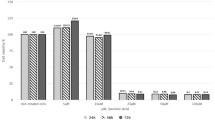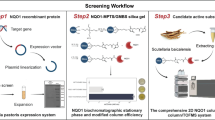Abstract
Background
Most of the bioactive peptides exhibit antioxidant effect and do elicit inhibitory effect on proliferation of cancer cells. This study investigates the in-vitro antioxidant and anti-cancer properties of NV14 peptide, derived from serine O-acetyltransferase (SAT) of spirulina, Arthrospira platensis.
Methods
The anti-cancer effect of the peptide was evaluated using human adenocarcinoma epithelial cells (MCF-7), while the anti-oxidant potential, as in reduction in ROS concentration, has been established using the H2O2-exposed, Madin-Darby canine kidney (MDCK) cells. The outcome of the in vitro analyses has been evaluated by in silico molecular docking analyses.
Results
The peptide, dose-dependently, reduced oxidative stress as well as cell proliferation. Besides, based on the binding scores between NV14 peptide and the important proteins associated with apoptosis and antioxidant defense, it is evident that the peptide has antioxidant and anti-cancer effect, in vitro.
Conclusions
Together, this study demonstrates that NV14 has a potent antioxidant and anti-cancer capability; however, further direction needs to be focused on clinical or pharmacodynamics aspects.






Similar content being viewed by others
Data Availability
The data used to support the findings of this study are available from the corresponding author upon request.
Code Availability
Not applicable.
Change history
18 April 2023
A Correction to this paper has been published: https://doi.org/10.1007/s11033-023-08383-8
References
Sigamani S, Ramamurthy D, Natarajan H (2016) A Review on Potential Biotechnological applications of Microalgae. J Appl Pharm Sci 6:179–184. https://doi.org/10.7324/JAPS.2016.60829
Sathya R, Mubarakali D, Mohamedsaalis J, Kim JW (2021) A systemic review on microalgal peptides: Bioprocess and sustainable applications. Sustain 13:1–15. https://doi.org/10.3390/su13063262
Marles RJ, Barrett ML, Barnes J et al (2011) United States Pharmacopeia Safety Evaluation of Spirulina. Crit Rev Food Sci Nutr 51:593–604. https://doi.org/10.1080/10408391003721719
Mysliwa-Kurdziel B, Solymosi K (2017) Phycobilins and Phycobiliproteins Used in Food Industry and Medicine. Mini-Reviews Med Chem 17. https://doi.org/10.2174/1389557516666160912180155
Sannasimuthu A, Ramani M, Pasupuleti M et al (2020) Peroxiredoxin of Arthrospira platensis derived short molecule YT12 influences antioxidant and anticancer activity. Cell Biol Int 44:2231–2242. https://doi.org/10.1002/cbin.11431
Krishnasamy G, Muthusamy K (2015) In vitro evaluation of antioxidant and antidiabetic activities of Syzygium densiflorum fruits. Asian Pac J Trop Dis 5:912–917. https://doi.org/10.1016/S2222-1808(15)60956-2
Fleischauer AT, Simonsen N, Arab L (2003) Antioxidant Supplements and Risk of Breast Cancer Recurrence and Breast Cancer-Related Mortality Among Postmenopausal Women. Nutr Cancer 46:15–22. https://doi.org/10.1207/S15327914NC4601_02
Desai K, Sivakami S (2004) SPIRULINA: THE WONDER FOOD OF THE 21 ST CENTURY. Asia Pac Biotech News 08:1298–1302. https://doi.org/10.1142/S021903030400223X
Velayutham M, Ojha B, Issac PK et al (2021) NV14 from serine O-acetyltransferase of cyanobacteria influences the antioxidant enzymes in vitro cells, gene expression against H2O2 and other responses in vivo zebrafish larval model. Cell Biol Int. https://doi.org/10.1002/cbin.11680
Zafar S, Beg S, Panda SK et al (2021) Novel therapeutic interventions in cancer treatment using protein and peptide-based targeted smart systems. Semin Cancer Biol 69:249–267. https://doi.org/10.1016/j.semcancer.2019.08.023
Bray F, Laversanne M, Weiderpass E, Soerjomataram I (2021) The ever-increasing importance of cancer as a leading cause of premature death worldwide. Cancer 127:3029–3030. https://doi.org/10.1002/cncr.33587
Sung H, Ferlay J, Siegel RL et al (2021) Global Cancer Statistics 2020: GLOBOCAN Estimates of Incidence and Mortality Worldwide for 36 Cancers in 185 Countries. CA Cancer J Clin 71:209–249. https://doi.org/10.3322/caac.21660
Mikaelian AG, Traboulay E, Zhang XM et al (2020) Pleiotropic anticancer properties of scorpion venom peptides: Rhopalurus princeps venom as an anticancer agent. Drug Des Devel Ther 14:881–893. https://doi.org/10.2147/DDDT.S231008
Velayutham M, Guru A, Arasu MV et al (2021) GR15 peptide of S-adenosylmethionine synthase (SAMe) from Arthrospira platensis demonstrated antioxidant mechanism against H2O2 induced oxidative stress in in-vitro MDCK cells and in-vivo zebrafish larvae model. J Biotechnol 342:79–91. https://doi.org/10.1016/j.jbiotec.2021.10.010
Crupi R, Palma E, Siracusa R et al (2020) Protective Effect of Hydroxytyrosol Against Oxidative Stress Induced by the Ochratoxin in Kidney Cells: in vitro and in vivo Study. Front Vet Sci 7:1–13. https://doi.org/10.3389/fvets.2020.00136
Su W, Wang L, Fu X et al (2020) Protective effect of a fucose-rich fucoidan isolated from saccharina japonica against ultraviolet B-induced photodamage in vitro in human keratinocytes and in vivo in Zebrafish. Mar Drugs 18. https://doi.org/10.3390/md18060316
Sarzaeem A, Mirakabadi AZ, Moradhaseli S et al (2012) Cytotoxic effect of ICD-85 (venom-derived peptides) on HeLa cancer cell line and normal LK cells using MTT assay. Arch Iran Med 15:696–701
Velayutham M, Sarkar P, Rajakrishnan R et al (2022) Antiproliferation of MP12 derived from a fungus, Aphanomyces invadans virulence factor, cysteine-rich trypsin inhibitor on human laryngeal epithelial cells, and in vivo zebrafish embryo model. Toxicon 210:100–108. https://doi.org/10.1016/j.toxicon.2022.02.019
Prabha N, Sannasimuthu A, Kumaresan V et al (2020) Intensifying the Anticancer Potential of Cationic Peptide Derived from Serine Threonine Protein Kinase of Teleost by Tagging with Oligo Tryptophan. Int J Pept Res Ther 26:75–83. https://doi.org/10.1007/s10989-019-09817-3
Moghadamtousi SZ, Kadir HA, Paydar M et al (2014) Annona muricata leaves induced apoptosis in A549 cells through mitochondrial-mediated pathway and involvement of NF-κB. BMC Complement Altern Med 14:1–13. https://doi.org/10.1186/1472-6882-14-299
Al-Harbi LN, Subash-Babu P, Binobead MA et al (2020) Potential metabolite nymphayol isolated from water lily (Nymphaea stellata) flower inhibits MCF-7 human breast cancer cell growth via upregulation of CDKN2A, PRB2, P53 and downregulation of PCNA mRNA expressions. Metabolites 10:1–14. https://doi.org/10.3390/metabo10070280
Zhou P, Jin B, Li H, Huang SY (2018) HPEPDOCK: A web server for blind peptide-protein docking based on a hierarchical algorithm. Nucleic Acids Res 46:W443–W450. https://doi.org/10.1093/nar/gky357
Mirdamadi S, Mirzaei M, Soleymanzadeh N et al (2021) Antioxidant and cytoprotective effects of synthetic peptides identified from Kluyveromyces marxianus protein hydrolysate: Insight into the molecular mechanism. Lwt 148:111792. https://doi.org/10.1016/j.lwt.2021.111792
Chen Z, Li W, Santhanam RK et al (2019) Bioactive peptide with antioxidant and anticancer activities from black soybean [Glycine max (L.) Merr.] byproduct: isolation, identification and molecular docking study. Eur Food Res Technol 245:677–689. https://doi.org/10.1007/s00217-018-3190-5
Zarei M, Shivanandappa T, Zarei M (2020) Natural bioactive 4-Hydroxyisophthalic acid (4-HIPA) exhibited antiproliferative potential by upregulating apoptotic markers in in vitro and in vivo cancer models. Mol Biol Rep 47:5343–5353. https://doi.org/10.1007/s11033-020-05617-x
Velayutham M, Guru A, Gatasheh MK et al (2022) Molecular Docking of SA11, RF13 and DI14 Peptides from Vacuolar Protein Sorting Associated Protein 26B Against Cancer Proteins and In vitro Investigation of its Anticancer Potency in Hep-2 Cells. Int J Pept Res Ther 28:87. https://doi.org/10.1007/s10989-022-10395-0
Ryang J, Liu F, Ng TB (2021) Purified antioxidant from the medicinal mushroom Phellinus pini protects rat H9c2 cell against H 2 O 2 -induced oxidative stress. J Food Biochem 45. https://doi.org/10.1111/jfbc.13818
Jayawardena TU, Wang L, Asanka Sanjeewa KK et al (2020) Antioxidant potential of sulfated polysaccharides from padina boryana; protective effect against oxidative stress in in vitro and in vivo zebrafish model. Mar Drugs 18:1–14. https://doi.org/10.3390/md18040212
Choi HI, Kim HJ, Park JS et al (2017) PGC-1α attenuates hydrogen peroxide-induced apoptotic cell death by upregulating Nrf-2 via GSK3β inactivation mediated by activated p38 in HK-2 Cells. Sci Rep 7:1–13. https://doi.org/10.1038/s41598-017-04593-w
Jung HY, Oh SH, Ahn JS et al (2020) Nox1 inhibition attenuates kidney ischemia-reperfusion injury via inhibition of ros-mediated erk signaling. Int J Mol Sci 21:1–19. https://doi.org/10.3390/ijms21186911
Liu Y, Yuan JM, Zhang LS et al (2015) Effects of tryptophan supplementation on growth performance, antioxidative activity, and meat quality of ducks under high stocking density. Poult Sci 94:1894–1901. https://doi.org/10.3382/ps/pev155
Abdullah ASH, Mohammed AS, Abdullah R et al (2014) Cytotoxic effects of Mangifera indica L. kernel extract on human breast cancer (MCF-7 and MDA-MB-231 cell lines) and bioactive constituents in the crude extract. BMC Complement Altern Med 14:1–10. https://doi.org/10.1186/1472-6882-14-199
Garrett MD, Collins I (2011) Anticancer therapy with checkpoint inhibitors: what, where and when? Trends Pharmacol Sci 32:308–316. https://doi.org/10.1016/j.tips.2011.02.014
Najm AAK, Azfaralariff A, Dyari HRE et al (2021) Anti-breast cancer synthetic peptides derived from the Anabas testudineus skin mucus fractions. Sci Rep 11:1–20. https://doi.org/10.1038/s41598-021-02007-6
Zhou P, Jin B, Li H, Huang SY (2018) HPEPDOCK: A web server for blind peptide-protein docking based on a hierarchical algorithm. Nucleic Acids Res 46:443–450. https://doi.org/10.1093/nar/gky357
Lee ACL, Harris JL, Khanna KK, Hong JH (2019) A comprehensive review on current advances in peptide drug development and design. Int J Mol Sci 20:1–21. https://doi.org/10.3390/ijms20102383
Author information
Authors and Affiliations
Contributions
MV and JA contributed to the concept and design of the study; MV. BH. MRG performed the experiments; AJ and JA contributed significantly to resources, data analysis, manuscript preparation and perform the analysis with constructive discussions; JA supervised and checked the manuscript; All authors read and approved the final manuscript
Corresponding author
Ethics declarations
Conflict of interest
All authors declare that they have no conflict of interest.
Ethical approval
This research does not contain any studies with human or animal participants by any of the authors.
Consent to participate
All the authors listed in the manuscript have approved the manuscript.
Consent for publication
The data provided in the manuscript is approved by all authors for publication.
Additional information
Publisher’s Note
Springer Nature remains neutral with regard to jurisdictional claims in published maps and institutional affiliations.
The original online version of this article was revised: The affiliation of the author "Annie Juliet" is corrected as "Foundation for Aquaculture Innovations and Technology Transfer (FAITT), Thoraipakkam, Chennai 600 097, Tamil Nadu, India."
Electronic supplementary material
Below is the link to the electronic supplementary material.
Rights and permissions
Springer Nature or its licensor (e.g. a society or other partner) holds exclusive rights to this article under a publishing agreement with the author(s) or other rightsholder(s); author self-archiving of the accepted manuscript version of this article is solely governed by the terms of such publishing agreement and applicable law.
About this article
Cite this article
Velayutham, M., Haridevamuthu, B., Priya, P.S. et al. Serine O-acetyltransferase derived NV14 peptide reduces cytotoxicity in H2O2 induced MDCK cells and inhibits MCF-7 cell proliferation through caspase gene expression. Mol Biol Rep 49, 9205–9215 (2022). https://doi.org/10.1007/s11033-022-07746-x
Received:
Revised:
Accepted:
Published:
Issue Date:
DOI: https://doi.org/10.1007/s11033-022-07746-x




